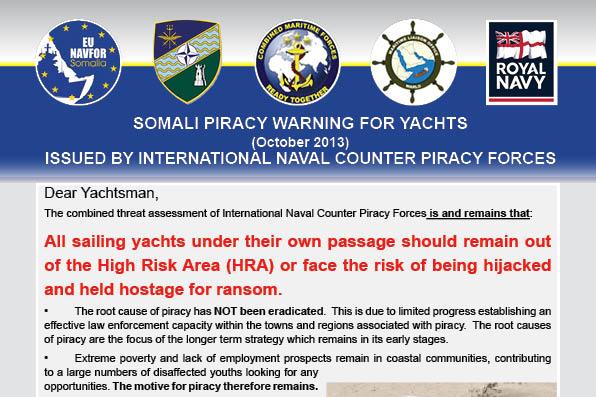If there was ever a good reason to heed naval forces’ warnings about the continuing threat from Somali piracy, then an attack on a super tanker is surely one of them.
As reported by the EU Naval Force last week, the fully laden super tanker was attacked by eight armed pirates on Friday 11 October, 230 miles off the Somali coast, with the attack only being thwarted by the armed security team on board. And earlier this week, a large fishing vessel was approached by 2 skiffs in a nearby sea area. Thankfully, both vessels employed self-protection measures and remained safe.
It is highly likely that a similar attack on a vessel not able to implement self-protection measures, such as a sailing yacht or pleasure-craft, would have resulted in the vessel being pirated and the crew taken for ransom.
Because of their vulnerability, it is highly recommended that all sailing yachts, under their own passage, should remain out of the High Risk Area (Southern Red Sea, Gulf of Aden and Western Indian Ocean).
In September representatives of the International Sailing Federation (ISAF), the Cruising Association, Ocean Cruising Club, Royal Cruising Club, Royal Yachting Association and the Royal yacht Squadron were invited to come to the EU Naval Force Operational HQ, to discuss the on-going piracy threat for sailing yachts in the Indian Ocean. This was the 5th such meeting between the naval forces, including NATO and Combine Maritime Forces and the Yachting Community. Following the meeting, a new advisory for yachts was issued. The advisory can be found on the EU Naval Force website, as well as the website of the Maritime Security Centre Horn of Africa and on the websites of the participating yachting organisations.
Whilst it is recognised that the levels of piracy have dropped over the past 18 months, due in no small part to the successful coordination and cooperation between naval forces and the maritime community, it is clear from these latest incidents that the pirates are still able and willing to get out to sea..
The fragile situation in Somalia has not changed, and pirates know that there are still life changing riches to be made at sea. If given an opportunity to attack a ship, they will take it, actively hunting ‘soft’ targets. It is estimated that over $330 million dollars was paid in ransoms between 2009 and 2012. The pirates only have to be lucky once, vessels sailing in the high risk area have to be vigilant every time. Pirates will exploit any perceived weakness in military response and vessels’ self-protection.
The warning from naval forces is clear: the piracy threat remains and yachts should avoid the High Risk Area.
